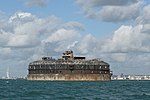No Man's Land Fort
Coastal artilleryPalmerston FortsSea Forts in the SolentSea forts

No Man's Land Fort, also referred to as No Man's Fort, is a sea fort in the Solent, near Portsmouth, England. It is one of the Palmerston Forts built between 1867 and 1880 after the recommendations of the 1859 Royal Commission. It is 200 feet in diameter, and lies 1.4 miles (2.3 km; 1.2 nmi) off the coast of the Isle of Wight.
Excerpt from the Wikipedia article No Man's Land Fort (License: CC BY-SA 3.0, Authors, Images).No Man's Land Fort
The Esplanade,
Geographical coordinates (GPS) Address Website External links Nearby Places Show on map
Geographical coordinates (GPS)
| Latitude | Longitude |
|---|---|
| N 50.739916666667 ° | E -1.0952166666667 ° |
Address
No Man's Land Fort
The Esplanade
PO34 5HB , Nettlestone and Seaview
England, United Kingdom
Open on Google Maps










